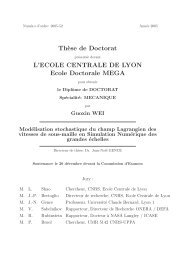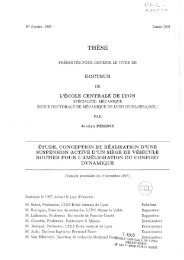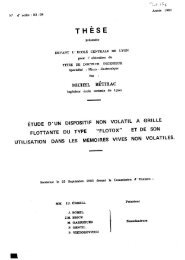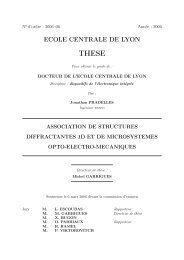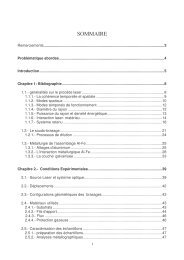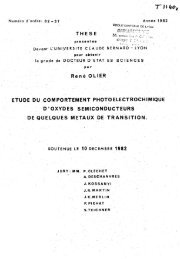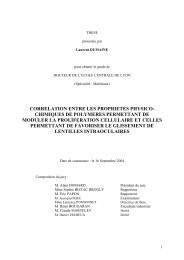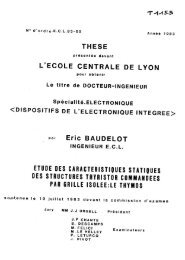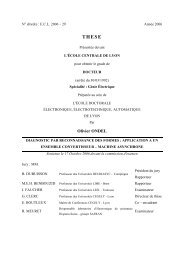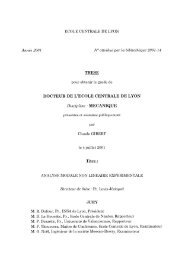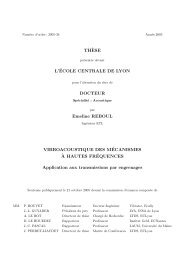Mohammed El-Amine SLAMA Étude expérimentale et modélisation ...
Mohammed El-Amine SLAMA Étude expérimentale et modélisation ...
Mohammed El-Amine SLAMA Étude expérimentale et modélisation ...
Create successful ePaper yourself
Turn your PDF publications into a flip-book with our unique Google optimized e-Paper software.
Experimental study and modelling of the influence of chemical<br />
constitution and repartition of pollution on flashover of high voltage<br />
insulators.<br />
Abstract<br />
This work aimed on optical and electrical characterization and mathematical<br />
modeling of flashover of polluted insulators, taking into account the applied voltage<br />
waveform, the distribution and chemical composition of pollutant deposit. Under<br />
lightning impulse voltage (1.2 / 50µs), the morphology of the discharge and the<br />
associated currents depend on voltage (shape, amplitude, polarity), the distribution<br />
of pollution and its conductivity. The measured average velocity of the discharge<br />
depends on the polarity applied to the tip and the pollution conductivity. The critical<br />
time corresponding to the critical conditions is about 9/10 of total flashover duration<br />
regardless of the polarity of the voltage and the pollution conductivity. The chemical<br />
composition of the pollution layer has little effect on the critical voltage unlike the<br />
critical currents. The values of the characteristic constants n and N depend on the<br />
chemical nature of the deposits and the voltage polarity. The developed model<br />
shows that the discharge constant characteristics n and N are dynamic param<strong>et</strong>ers<br />
and depend on the elements of the equivalent electrical circuit system and thermal<br />
param<strong>et</strong>ers of the discharge. The developed relationships of critical conditions of<br />
flashover link the electrical param<strong>et</strong>ers and thermal equivalent circuit and the<br />
propagation condition of the discharge. This approach allows us to understand the<br />
effect of the chemical constitution of pollution on the values of n and N. The<br />
application of this model for various voltage waveforms and for several types of<br />
pollution, gives satisfactory results. The assumption that the column of the discharge<br />
contains only water vapor and air is a good approximation of the critical conditions.<br />
Under lightning impulse voltage, the current circulate into a effective section of the<br />
pollution surface. The introduction of the concept of critical effective thickness of<br />
pollution and its application to the calculation of critical param<strong>et</strong>ers gives good<br />
results compared with the experimental values. We have also shown that the<br />
effective thickness of the deposit is proportional to the resistivity of the pollution and<br />
depends on voltage polarity and pollution configuration. In the case of discontinuous<br />
deposit of pollution and / or non-uniform propagation conditions of discharges are<br />
local and their characteristic param<strong>et</strong>ers vary depending on the configuration and<br />
the conductivity of the deposit and the polarity of the applied voltage. The<br />
developed model gives good results.<br />
Key-words: High voltage - Insulator– Pollution – <strong>El</strong>ectrical discharge – Flashover –<br />
Chemical constitution of pollution – Discharge constants – Discharge temperature –<br />
Critical conditions – Effective thickness – Pollution repartition.<br />
6



